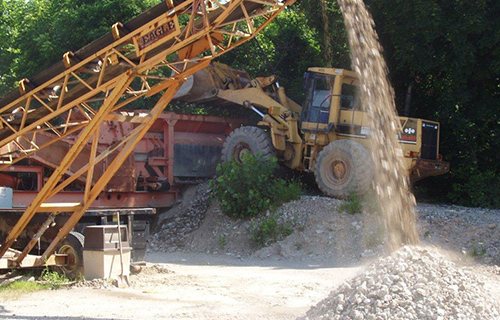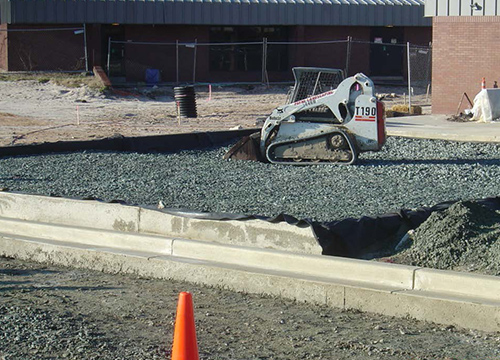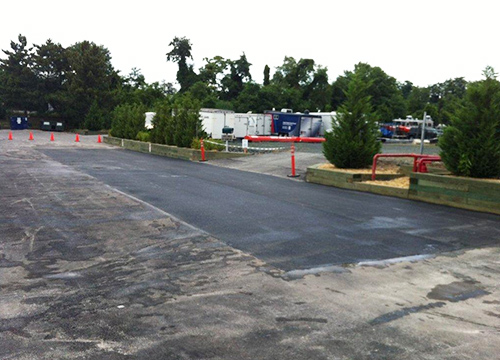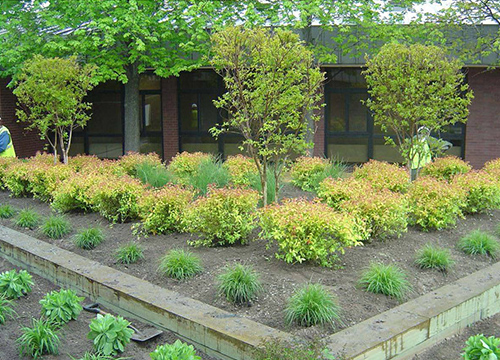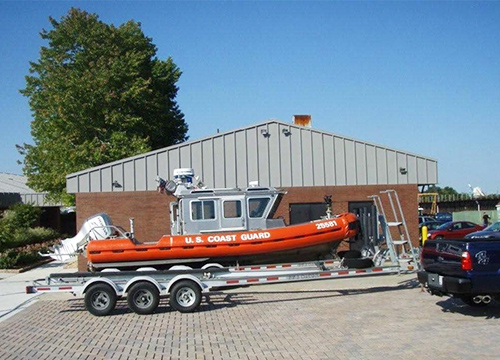Green Remediation Focus
Curtis Bay Coast Guard Yard
Baltimore, Maryland
Superfund Removal & NPL
Cleanup Objectives: Remove and dispose of soil and sediment contaminated by semi-volatile organic compounds, metals, polychlorinated biphenyls, dioxin and other hazardous chemicals due to past use of the site for design, construction and repair of ships and boats. Areas targeted for remediation at this 113-acre site include dry dock locations, a salvage lot, a former incinerator and burn area, sandblast residue and bilge slop areas and an acid tank area. Curtis Creek, a tidally-influenced tributary of the Patapsco River (a tributary of the Chesapeake Bay), forms the site's southern boundary.
Green Remediation Strategy: The strategy involved best management practices (BMPs) focused on conserving fuel, reducing air emissions and waste generation, and integrating a green infrastructure for cleanup and ongoing site activities. The BMPs included:
- Treating contaminated soil onsite to allow its disposal at a nearby non-hazardous waste facility, rather than disposing of it at a distant hazardous waste landfill.
- Reusing or recycling materials and objects that were excavated or dredged incidentally during soil or sediment removal.
- Integrating a green infrastructure to maximize infiltration and storage of rainwater and snow melt and to minimize stormwater-related erosion.
- Creating green space in former industrial areas.
- Setting cleanup objectives at the more stringent residential standards rather industrial standards to create more options for future use of the property.
Implementation of the green remediation strategy was integral to the U.S. Coast Guard's plan for long-term site stewardship, including current post-cleanup monitoring of groundwater. The stewardship plan includes reliance on renewable energy; the ongoing shipyard activities are now 100% powered by an onsite co-generation plant that uses methane gas supplied by the nearby Baltimore City-owned Quarantine Road Landfill.
Results:
Energy Conservation and Air Emission Reduction
- Reduced consumption of diesel fuel associated with waste shipping by approximately 82,000 gallons, by treating the full volume (25,500 tons) of contaminated soil onsite so it could be disposed of at a nearby non-hazardous waste landfill rather than a distant hazardous waste landfill. The soil was treated by mixing a chemical reagent directly into the soil to convert leachable metals into stable insoluble minerals. This treatment and disposal strategy, which was estimated to avoid 534,000 trucking miles and significant fees for hazardous waste disposal, saved approximately $6 million in project costs.
- Avoided approximately 700 tons of greenhouse gas emissions due to the reduction in waste shipping distance.
Water Preservation
- Capturing and retaining water during intense rainfall or snowmelt events in the remediated former burn pit area via tiered planter boxes installed between the area's new buildings and a parking lot.
- Increasing precipitation infiltration in the remediated former salvage lot via porous paver tiles that substituted solid concrete around a new maintenance building positioned at that location. Avoidance of impermeable materials on the ground surface also reduces potential soil/sediment erosion and reduces loads on the municipal stormwater sewer system.
- Increasing infiltration and reducing stormwater runoff additionally across the site through use of conventional practices such as constructing retaining walls and surface water diversion channels in vulnerable areas.
Materials and Waste Management
- Recycled a total of approximately 2,620 tons of concrete. An estimated 2,260 tons of concrete from building slabs and foundations undergoing demolition was crushed, sized and used as backfill in the former burn area, and approximately 360 tons of concrete supporting a former bulkhead was locally recycled.
- Recycled approximately 20 tons of steel extracted during soil excavation and sediment dredging.
- Recycled approximately 110 tons of timber extracted during soil excavation and sediment dredging.
- Recycled approximately 2,050 tons of petroleum-contaminated soil rather than disposing of it in a non-hazardous waste landfill. After excavation and confirmatory testing, the soil was shipped to Clean Earth of Maryland, Inc., (approximately 90 miles away, in Hagerstown, Maryland) for reuse as road construction material.
Land and Ecosystems
- Removed more than 6,000 tons of contaminated sediment from the bottom of Curtis Creek to restore the surface water quality and avoid potential transport of contaminated sediment through waterways in the greater Chesapeake Bay watershed. Removal rather than treatment of contaminated sediment as well as contaminated soil also enabled the project to more quickly meet residential cleanup standards.
- Created approximately 60,000 square feet of green space at the former burn area after excavation and concrete removal was complete.
- Minimized future activities associated with caring for the new green space and for target areas where vegetation was introduced to control soil erosion, by selecting grasses, shrubs and trees requiring little or no maintenance.
Property End Use: Ship building and repair for the U.S. Coast Guard
Point of Contact: Gerald Hoover, U.S. Environmental Protection Agency Region 3
Update: June 2016



